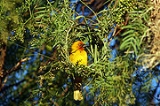
Cape Weaver
Encyclopedia
The Cape Weaver is a resident breeding bird
species endemic to South Africa
.
This common species occurs in grassland, agricultural and fynbos
habitats, often near rivers. In breeds in noisy colonies in trees (often willow
s or Eucalyptus
, rarely palms
) and reedbeds.
This weaver builds a large coarsely woven nest made of grass and leaf strips with a downward facing entrance which is suspended from a branch or reed. The Hadada Ibis
will sometimes nest in the weaver colonies. The Cape Weaver feeds on a wide variety of seeds, grain and insect
s. The calls of this bird include a harsh azwit, azwit.
The adult female has an olive-yellow head and breast, shading to pale yellow on the lower belly. Her eyes are brown. Young birds are similar to the female.
Bird
Birds are feathered, winged, bipedal, endothermic , egg-laying, vertebrate animals. Around 10,000 living species and 188 families makes them the most speciose class of tetrapod vertebrates. They inhabit ecosystems across the globe, from the Arctic to the Antarctic. Extant birds range in size from...
species endemic to South Africa
South Africa
The Republic of South Africa is a country in southern Africa. Located at the southern tip of Africa, it is divided into nine provinces, with of coastline on the Atlantic and Indian oceans...
.
This common species occurs in grassland, agricultural and fynbos
Fynbos
Fynbos is the natural shrubland or heathland vegetation occurring in a small belt of the Western Cape of South Africa, mainly in winter rainfall coastal and mountainous areas with a Mediterranean climate...
habitats, often near rivers. In breeds in noisy colonies in trees (often willow
Willow
Willows, sallows, and osiers form the genus Salix, around 400 species of deciduous trees and shrubs, found primarily on moist soils in cold and temperate regions of the Northern Hemisphere...
s or Eucalyptus
Eucalyptus
Eucalyptus is a diverse genus of flowering trees in the myrtle family, Myrtaceae. Members of the genus dominate the tree flora of Australia...
, rarely palms
Arecaceae
Arecaceae or Palmae , are a family of flowering plants, the only family in the monocot order Arecales. There are roughly 202 currently known genera with around 2600 species, most of which are restricted to tropical, subtropical, and warm temperate climates...
) and reedbeds.
This weaver builds a large coarsely woven nest made of grass and leaf strips with a downward facing entrance which is suspended from a branch or reed. The Hadada Ibis
Hadada Ibis
The Hadada or Hadeda Ibis, Bostrychia hagedash, is an ibis found in Sub-Saharan Africa.-Appearance:The Hadeda is a large , dark brown ibis with a white "moustache", glossy greenish purple wings, a large black bill with a red stripe on the upper mandible, and blackish legs.-Call:It has a...
will sometimes nest in the weaver colonies. The Cape Weaver feeds on a wide variety of seeds, grain and insect
Insect
Insects are a class of living creatures within the arthropods that have a chitinous exoskeleton, a three-part body , three pairs of jointed legs, compound eyes, and two antennae...
s. The calls of this bird include a harsh azwit, azwit.
Description
The Cape Weaver is a stocky 17 cm long bird with streaked olive-brown upperparts and a long pointed conical bill. The breeding male has a yellow head and underparts, an orange face, and a white iris.The adult female has an olive-yellow head and breast, shading to pale yellow on the lower belly. Her eyes are brown. Young birds are similar to the female.

